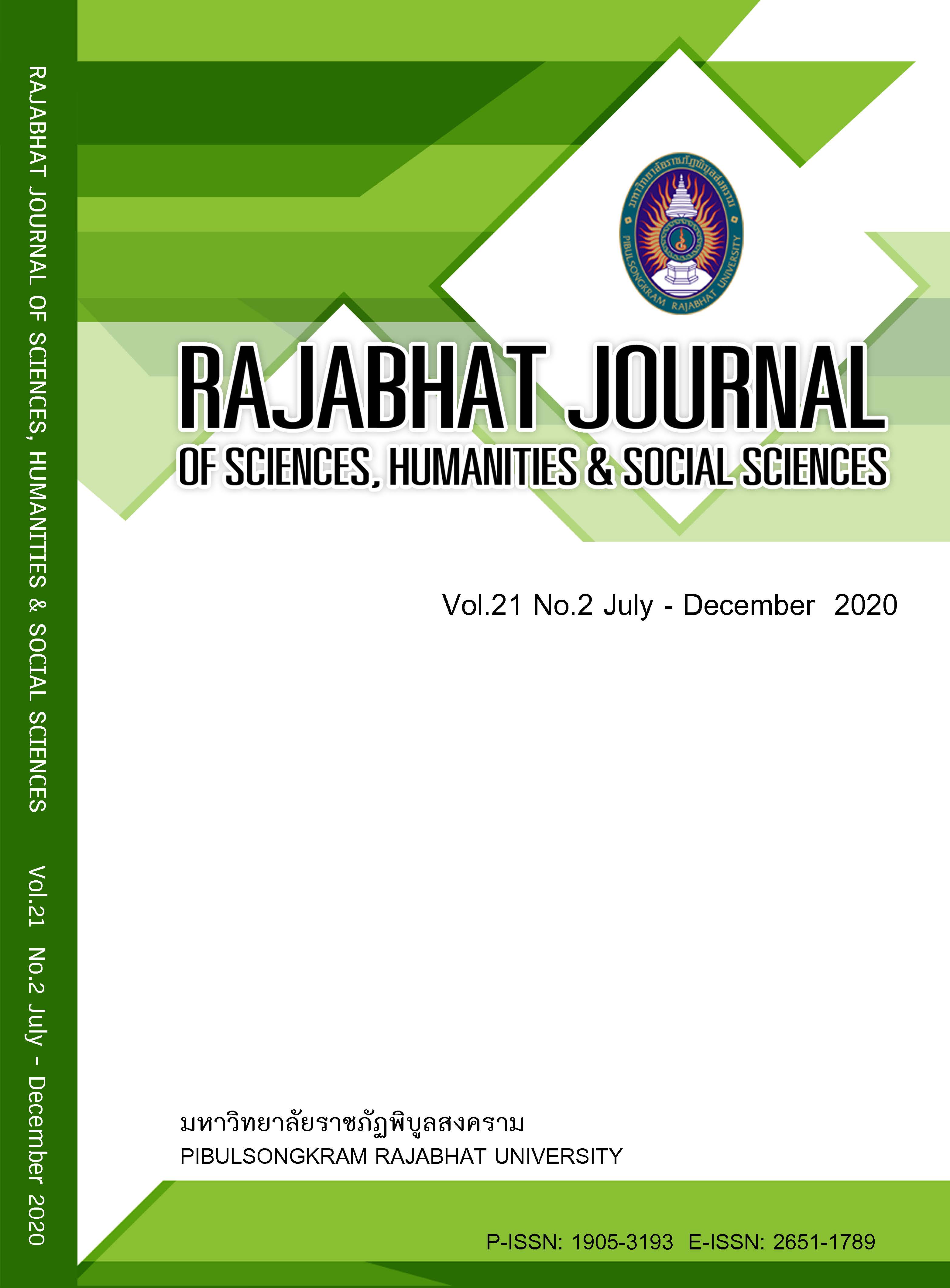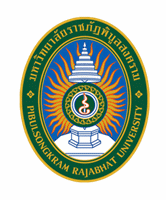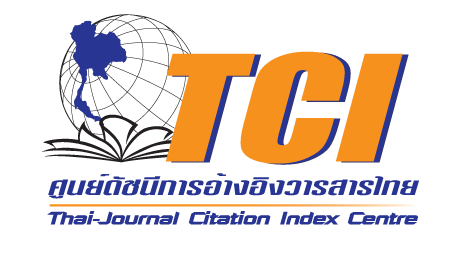หุ่นยนต์สนทนาบนพื้นฐานปัญญาประดิษฐ์ สำหรับการให้บริการห้องสมุดดิจิทัล
คำสำคัญ:
ปัญญาประดิษฐ์, หุ่นยนต์สนทนา, ห้องสมุดดิจิทัลบทคัดย่อ
งานวิจัยเรื่อง หุ่นยนต์สนทนาบนพื้นฐานปัญญาประดิษฐ์สำหรับการให้บริการห้องสมุดดิจิทัล ใช้หลักการเรียนรู้ของเครื่องด้วยวิธีการเรียนรู้แบบมีผู้สอน มาเรียนรู้บทสนทนาของผู้ใช้บริการในปริมาณมาก มีการใช้เทคนิคการจำแนกข้อมูลเพื่อจำแนกคุณลักษณะของคำหรือรูปประโยค ด้วยแบบจำลองที่ใช้คำนวณค่าความน่าจะเป็นของชุดอักขระ และนำไปประมวลผลภาษาธรรมชาติ จากนั้นวิเคราะห์ด้วยอัลกอริทึมวินโนว์ ออกมาเป็นโมเดล เพื่อพยากรณ์ในแต่ละประโยคของการสนทนาระหว่างผู้ใช้บริการและผู้ให้บริการ เครื่องมือที่ใช้ในการวิจัยในครั้งนี้คือ ภาษาที่ใช้ในการพัฒนาโปรแกรมคือ AngularJS (Front-End) และ NodeJS (Back-End) ฐานข้อมูลที่ใช้บนกลุ่มเมฆ คือ MongoDB (Amazon Web Service) พื้นที่เก็บโปรแกรมบนกลุ่มเมฆคือ Firebase (Front-End) และ Heroku (Back-End) พื้นที่เก็บซอร์สโค้ดที่ใช้คือ Bitbucket ผลการวิจัย พบว่าการพัฒนาหุ่นยนต์สนทนาบนระบบส่งข้อความของเฟสบุ๊ค โดยนำหลักการปัญญาประดิษฐ์ ผู้วิจัยใช้ข้อความการสนทนาจำนวน 3,361 ข้อความ จากกลุ่มตัวอย่างผู้ใช้บริการ 220 คน แบ่งเป็นข้อความของผู้ใช้บริการจำนวน 1,987 ข้อความ และผู้ให้บริการจำนวน 1,374 ข้อความ นำข้อความของผู้ใช้บริการมาคัด Feature ที่ Feature Engineering เหลือ 1,254 ข้อความ กำหนด Labels เข้าฟังก์ชั่น N-Gram โดยใช้ N-Gram of Letter คือตัดเป็นพยางค์ และเลือก N = 3 การทดสอบประสิทธิภาพของโมเดลที่จะนำไปใช้กับหุ่นยนต์สนทนาบนเฟสบุ๊คสำหรับการให้บริการห้องสมุดดิจิทัล ได้ผลลัพธ์คือโมเดลที่ถูกแบ่งระดับชั้นให้ลึกลงไปถึง 3 ระดับ หลังจากนั้นได้นำโมเดลที่ได้ไปทดสอบด้วยวิธีการ Cross Validation K-Foldโดย K=10 เหมือนกับทดสอบกับชุดข้อมูลแรก เมื่อแบ่งกลุ่มย่อยตามตารางความลึกของการฝึกสอน 3 ระดับ จึงได้ผลลัพธ์การวัดประสิทธิภาพโมเดลจำนวน 15 โมเดล พบว่าค่าเฉลี่ยความแม่นยำคือ 95.28% ซึ่งเป็นประสิทธิภาพที่สามารถนำไปใช้งานสำหรับการบริการห้องสมุดดิจิทัล
References
Choemprayong S. Challenges Librarians and Informationists are Facing. Thai Library Associat. 2019: 3(2); 96-101.
Faceblog. This Social Network Information Blog. 2019. Retrieved from faceblog.in.th. Available at: https://faceblog.in.th/2011/07/wordpress-twitter-google-plus-statistics/Ivanovskaya. Accessed 29 January 2019.
He W, Guoqiang Y, Li DX. Devloping Vehicular Data Cloud Services in the IoT Environment. IEEE Transactions on industrial Informatics. 2014: 10(2); 1587-1595.
Indra ASM, Bhuva N. Enhancing the Academic Library Experience with Chatbots: An Exploration of Research and Implications for Practice. Journal of the Australian Library and Information Association. 2019: 68(3); 268-277.
Ivanovskaya A, Aksyonov K, Kalinin I. et al. Development of the text analysis software agent (chat bot) for the library based on the question and answer system. 2019. ITM Web of Conferences. 30, 2019; 1-6.
Lokman AS, Zain JM. Chatbot Enhanced Algorithms: A Case Study on Implementation in Bahasa Malaysia Human Language. Springer-Verlag Berlin Heidelberg. 2010: 87; 31-44.
Machin L. Why Machine Learning Matters. Retrieved from Math work. 2020. Available at: https://uk.mathworks.com/discovery/machine-learning.html?s_tid=srchtitle. Accessed 20 January 2020.
Mckie IAS, Narayan B. Enhancing the academic library experience with chatbots: an exploration of research and implications for practice. Journal of the Australian Library and Information Association. 68(3); 23-25.
Mikhail B, Alexander S, Rafael A. et al. DeepPavlov: Open-Source Library for Dialogue Systems. Proceedings of the 56th Annual Meeting of the Association for Computational Linguistics-System Demonstrations. 2018. Melbourne, Australia, 122–127.
Scott S, Matwin S. Feature Engineering for Text Classification in ICML, vol.99. Citeseer, 1999; 379–388.
Vahabzadeh A, Sahin N, Kalali A. Digital Suicide Prevention: Can technology become a game changer. Journal of Innovations in Clinical Neuroscience. 2016: 13(1); 16-20.
Wallace R. AIML Pattern Matching Simplified. 2003. Available at: http://alicebot.org. Accessed 20 January 2020.
Weizenbaum J. ELIZA-A Computer Program For the Study of Natural Language. Communication of the ACM. 1966: 9(1); 178-183.
Downloads
เผยแพร่แล้ว
How to Cite
ฉบับ
บท
License
Each article is copyrighted © by its author(s) and is published under license from the author(s).









